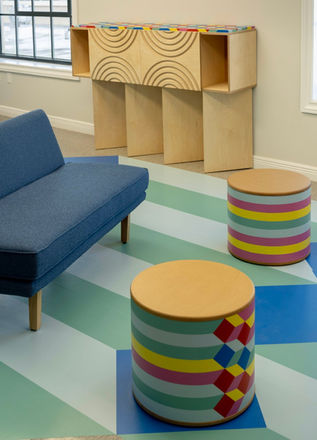2022
EDUCATION LAB
Museum of Art & Design, Miami, FL
As part of a multi-year project, MOAD commissioned the designers of AMLgMATD to reinvent its existing education room and make it adaptable to the variety of educational programs offered by the Museum, ranging from lectures and workshops for adults and students to hands-on art-making activities with children. They created a dynamic array of bespoke cabinetry, furniture, and wall and floor coverings that can be reconfigured for multiple uses. Monochromatic wooden surfaces alternate with strategically deployed moments of strong, vivid colors. AMLgMATD used sustainable, healthy and recycled materials, and invented a unique and engaging hybrid style called “Tropical Cubism.”
AMLgMATD’s design includes storage cabinets with carved designs on their doors, shelves that reveal colorful abstractions between shelves, work tables that can be arranged in a multitude of configurations, and geometric floor decals in hues bold designs that echo the optical designs wrapped around the low stools. Materials used include birch plywood, MDF (medium-density fiberboard, recycled from previous MOAD exhibits), aluminum tubing (60% recycled), vinyl laminate flooring, polypropylene webbing ( old unused stock) and environmentally friendly non-toxic coatings. The furniture was designed and built for the bedroom in small modules and assembled on site. The innovative design makes it easy to reconfigure the room and easily disassemble and reassemble furniture when needed. The furniture was custom made by master cabinetmaker Rudi Repenning. Moonlighter FabLab provided all CNC (Computer Numerical Control) services for the custom machine cutting and routing of the project.
According to AMLgMATD founders Laz Ojalde and Natalie Zlamalova, the designers’ approach to designing the space was to create “a fictional historical narrative for the room by developing a new style called Tropical Cubism.” This new style is inspired by the mixture of Czech cubism/functionalism and the whimsy of tropical American art deco. The resulting look highlights the most important features and processes of both influences and reuses them in contemporary ways.
Czech Cubism was defined by its use of sharp angles, crystalline forms and repetitive forms, as well as the use of avant-garde and modern materials of the time, such as aluminum and plywood, and exploration of new synthetic materials. Tropical Art Deco, a colorful take on the French and American Art Deco styles, combines the bold geometric shapes of Cubism and Viennese Secession with additional whimsical thematic elements.
“In creating this pseudo-style,” says AMLgMATD, “we deliberately chose to use economical material processes that were newly developed and perfected during the source styles period, such as plywood construction, bending of metal tubes, quick fixing and mechanical weaving. On top of that, we use modern conveniences in technology and decorative application: CNC routing, vinyl wraps, latex paints and non-toxic coatings. Our goal for this room is to create a space where the past artistically inspires the present, while creating an environment that pays homage to our personal historical influences.
The redesign of the Education Lab is made possible with the support of the Miami-Dade County Department of Cultural Affairs and Council of Cultural Affairs, the Miami-Dade County Mayor and County Board of Commissioners; and the State of Florida, Department of State, Division of Arts and Culture, and the Florida Council on Arts and Culture.
Featured in the March 2022 Interior Design Magazine online






















